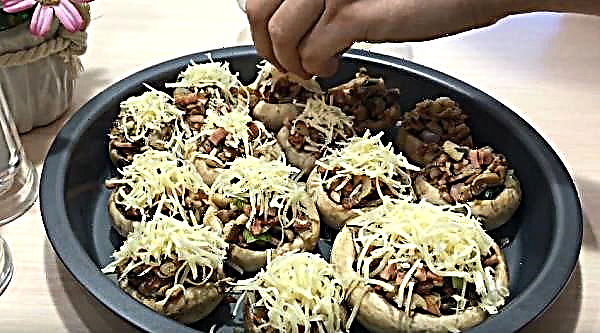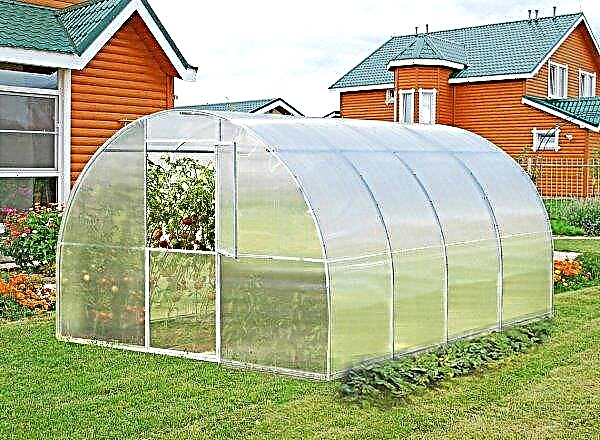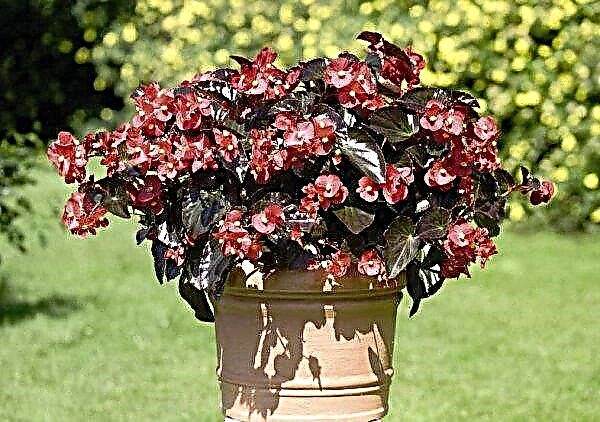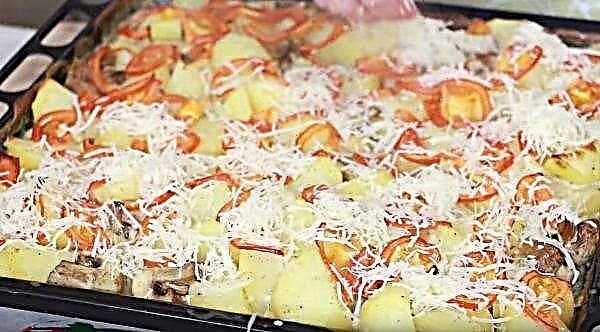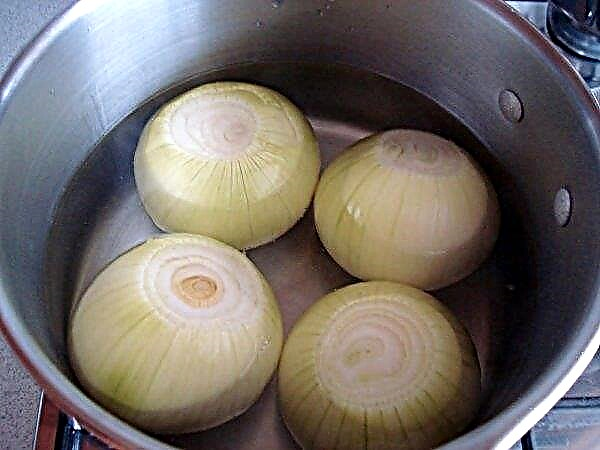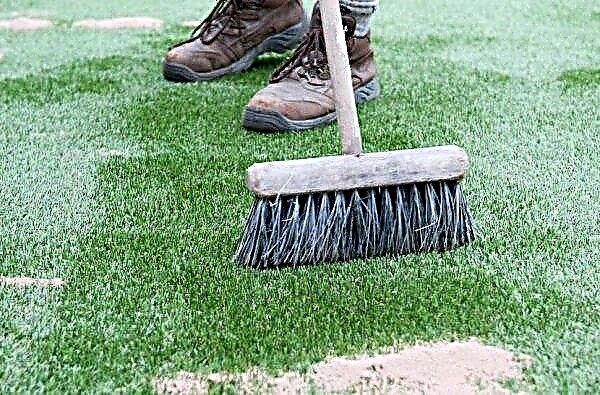Getting a large number of delicious eggplants directly depends on the successfully selected variety. However, their abundance sometimes poses a difficult task for summer residents to choose the best copies. The article contains information about one of the most popular hybrids - Bourgeois F1.
Description and characteristics of the variety
The first-generation hybrid Bourgeois is a product of the work of Russian breeders of the SeDec company. Its official registration took place in 2007. Eggplant of this variety ripens in the early stages - harvesting can be done 105-110 days after emergence.
The plants form not too tall and not sprawling bushes - up to 1.6 m high. Their stalk is strong, has light pubescence. Green leaves with wave-shaped edges. The main distinguishing feature of the hybrid is the shape of the fruit - they, unlike most varieties, are spherical. In appearance, they are more similar to tomatoes than to traditional oblong blue ones. The diameter of one fruit is 13 cm, the mass is 330 g.
The record-breaking fruits reached a weight of 0.5–0.6 kg. Eggplant peel is dark purple, shiny. The pulp is white with a green tint, dense. There is no bitterness in it. Taste, marketable and transportable qualities of fruits are noted at a high level.
The average level of hybrid productivity is 4.7 kg / 1 m². On one plant grown in the garden, up to 6 fruits can be planted. Bushes in the greenhouse are able to bring 10 blue ones. Harvest can be harvested for 1-1.5 months.
The hybrid is characterized by resistance to many diseases. It can maintain a high yield when grown in adverse conditions. Suitable for cultivation in the open air and in the greenhouse.
Advantages and disadvantages of the variety
- The advantages of the bourgeois hybrid include:
- it stably shows good yield;
- the fruits have an unusual appearance, are well transported and retain their presentation, which makes them promising for sales;
- harvesting lasts a long period;
- characterized by resistance to many diseases and harmful insects that affect the culture of the nightshade family;
- the bushes do not need a garter;
- fruits are suitable for various culinary purposes.
Did you know? In the botanical systematization, the fruits of eggplant are berries; in cooking, it is customary to consider them vegetables.
- Unfortunately, the eggplant Bourgeois is not without its drawbacks:
- its seeds germinate for a long time;
- It makes high demands on the presence of moisture;
- necessarily need a bush formation;
- responds poorly to a dense landing.
Growing Features
Eggplant bourgeois is rarely grown and only in regions with a warm climate. It is preferable to plant these little blue ones using seedlings. So the plants will come out stronger, and the first fruits can begin to be harvested much earlier.
Seedling for seedlings
Seeds are recommended to be planted in late February - early March. Before they are planted in the soil mixture, it is necessary to carry out processing that will avoid infection with some diseases and pests and improve their germination.
Presowing treatment includes:
- placing seeds for 20-30 minutes in a solution of potassium permanganate;
- washing the planting material, packing it in fabric bags and placing it for 24 hours in a solution prepared from 1 tsp. wood ash (nitrophosphate, potassium humate) and 1 liter of water with a temperature of + 25 ... + 28 ° С;
- washing the seeds and placing them for germination for 24–48 hours in temperature conditions + 25 ... + 30 ° С and constantly maintained humidity.
To harden the seeds, they are exposed to sudden temperature changes: for 2 days they are placed on the lower shelf of the refrigerator, and then for 1 day in a room with a temperature of + 25 ... + 30 ° С. The hardening cycle is repeated again.
In addition to seeds, for planting seedlings, tanks and soil should also be prepared. The containers can be different - special, purchased in the store (peat glasses, cassettes), or those that were found at hand (boxes, trays). Ordinary plastic glasses will do. Soil for seedlings can be purchased at the store or prepared yourself.
Important! It is advisable to sow the seeds in separate containers, since when growing in a common tray, picking is required, and this can lead to damage to the fragile roots of the plant and growth retardation.
Here are some options for soil composition:
- Combine river sand (1 part) with lowland peat (4 parts) and compost (3 parts).
- Mix humus (8 parts) with turf soil (2 parts) and rotted mullein (1 part).
- Prepare a mixture of peat (3 parts) and rotted sawdust (1 part).
- Mix humus (2 parts) with turf soil (1 part).
- Combine humus (2 parts) with peat (1 part).
Purchased soil does not need disinfection. A self-made substrate must be disinfected.
There are several ways to pickle:
- In the oven at a temperature of +80 ... + 90 ° С for 20–40 minutes.
- In a steam bath for 40 minutes.
- In the microwave at maximum for 10 minutes.
- By watering with a pink solution of potassium permanganate.
- Watering boiling water.
 Etched soil will need to be fed with potassium sulfate (0.5 tbsp. / 10 kg of soil) or wood ash (1 tbsp. / 10 kg of soil). After this treatment, the soil is placed in warm conditions. Sowing can be done after 2 weeks.
Etched soil will need to be fed with potassium sulfate (0.5 tbsp. / 10 kg of soil) or wood ash (1 tbsp. / 10 kg of soil). After this treatment, the soil is placed in warm conditions. Sowing can be done after 2 weeks.The technology of planting seeds is as follows:
- Fill each container with soil.
- Moisturize.
- Put in containers of 2-3 seeds.
- Sprinkle soil with a layer of 2 cm.
- Tamp a little.
- Cover with foil.
- Place in a room with a temperature of + 25 ... + 30 ° С.
Important! When growing eggplant, crop rotation rules must be observed. The best predecessors for this crop are green manure, onion, garlic, peas, beans, cabbage. The worst - pumpkin, potato, sunflower.
Sprout care
If all the procedures for soaking the planting material have been carried out, then the first shoots should be expected after 5-6 days. At this point, it is necessary to remove the shelter and place the crops in temperature conditions of + 14 ... + 16 ° C in the daytime and + 10 ... + 12 ° C in the night.
Further they act as follows:
- Using artificial lighting, daylight hours are set for 12 hours.
- After 7 days, the temperature conditions are changed to warmer - + 25 ... + 27 ° C. The night temperature should be kept at + 12 ... + 14 ° С.
- All the time they monitor the condition of the soil and, as necessary, moisturize it from the spray gun.
- When 2 true leaves appear, they are fed with a mixture of superphosphate, potassium salt and urea.
- After 14 days, top dressing is repeated.
- 2 weeks before the expected date of transfer of seedlings to the main place of growth, they begin hardening - they take out sprouts daily to fresh air, gradually increasing the length of stay.
- 1 day before planting, seedlings are abundantly watered.
Important! When growing seedlings in one tank when 2 true leaves appear, it is necessary to pick.
Planting seedlings in a permanent place
Sprouts are transferred to the beds at the age of 2 months, that is, in May - June. By this time, seedlings should be at least 10 cm tall and have 5-7 leaves.
The process of planting seedlings at a constant place of growth is as follows:
- In the area selected for eggplant cultivation, holes are made according to the 40 × 60 cm pattern.
- Wells are plentifully watered.
- Each sprout is planted in a separate hole to a depth of 2 cm.
- Sprinkle the roots.
- The soil is compacted and mulched with dry earth or peat.
- Landings are covered with a film or non-woven material.
- Shelter is removed when warm weather sets in and the risk of frost is passed.
Grade Care
Eggplant can be called one of the most capricious garden crops. It is demanding on temperature and humidity, the composition and structure of the soil, sensitive to damage to the roots, many diseases and pests.
In order to achieve a high-quality crop, regular care is required, which consists of watering, moistening, loosening the soil, weeding, forming a bush, preventive spraying against pathogens and harmful insects.
Watering and fertilizing
After planting, the first watering is carried out after 10-14 days. Prior to this, care for young sprouts will consist only in shallow loosening of the soil and periodic spraying. In the future, establish the irrigation regime with a frequency of 2 times a week. For moisturizing use only warm water.
Eggplants respond well to top dressing. It is recommended to feed them once every 1.5 months with an aqueous solution of wood ash (1 tbsp. / 10 l) or sprinkle the substance in dry form between the rows. Also good are bird droppings, mullein, green fertilizers.
If you are a supporter of the application of mineral fertilizers, then the plant can be fed 3 times per season:
- 2-3 weeks after transplanting seedlings to a permanent place.
- In the process of forming fruits on the side shoots.
- When the first fruits appear.
At the first feeding, nitrogen is required, and at subsequent feeding, potassium and phosphorus are required. Ammophoska, superphosphate, urea (10–40 g / 1 liter of water) are used.
Did you know? Eggplant was first grown about 1.5 thousand years ago in the countries of the Middle East, South Asia and India. This is mentioned in ancient Sanskrit texts.
Bush formation
Since Bourgeois has large fruits, it is difficult for bushes to cope with their abundance. The more fruits on the bush, the smaller they come out. Therefore, during the formation of the ovaries, 3-5 stepsons and up to 8 fruits should be left on each plant. Pasynkovka produce in the morning on a not too hot day in the absence of precipitation. The shoots are removed manually.

To form a bountiful crop, flowers need a lot of light. However, abundant foliage can shade them. Therefore, it is important to ensure that there are not too many sheets, and remove them as necessary.
Pest and Disease Control
Eggplant is a delicate plant that, when improperly planted and maintained, as well as in the absence of preventive measures, is often affected by diseases and attacked by harmful insects.
Of the ailments, the following are the most dangerous for the blue ones:
- Late blight. The disease is manifested by the appearance of brown spots on the leaves, which later dry up and fall off. For treatment, spraying is used with a 0.2% solution of copper sulfate, 1% Bordeaux liquid. Prevention consists in processing infusion of garlic (200 g / 3 l of water, insist 3 days, dilute with water 1 to 1), whey (1 to 1 with water).

- Blackleg. The main symptoms are blackening, gray coating, thinning of the root neck. As a result of the defeat, the plant dries and dies. Affected bushes need to be removed and burned in a timely manner, the soil should be treated with any fungicide. To exclude the disease, the seeds before planting should be soaked in a solution of potassium permanganate.

- Anthracnose. When infected, brown spots form on the leaves and sunken spots on the fruits. For control, treatment is applied with 0.2–0.4% solution of “HOM”.
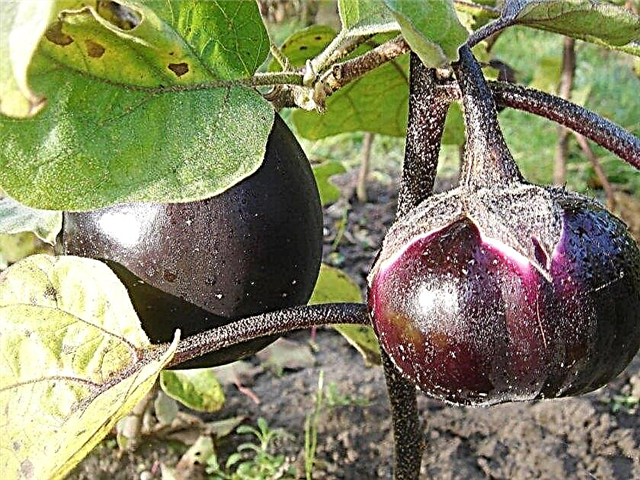
Among the harmful insects that can cause huge damage to the crop:
- Colorado beetle. His presence is easy to notice. This is a large insect with striped wings. The larvae are also large, pink in color. They can eat foliage almost completely. They fight the beetle with insecticide treatment Calypso, Prestige. With a slight infection, insects are collected by hand. To scare them away from planting, horseradish, calendula, coriander, and beans are planted in the immediate vicinity of the eggplant.
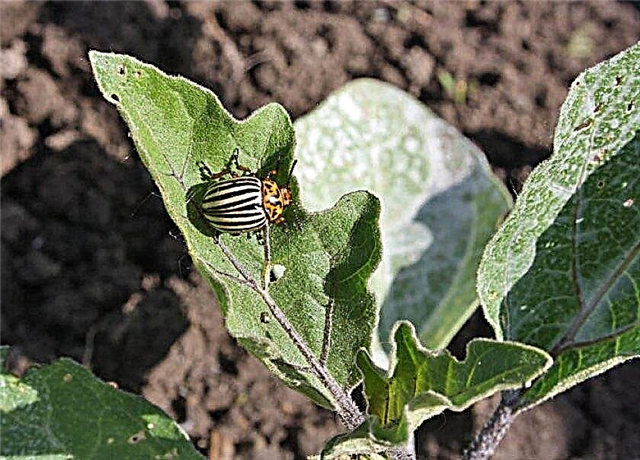
- Spider mite - in the process of its activity leaves a web on leaves and stalk. This is a small sucking insect of red or black color that lives on the bottom leaf plate. It feeds on plant juices. Therefore, soon after its invasion, you can notice how the leaves wither and dry out, and then the whole bush. Against a tick use "Nitrofen", colloidal sulfur, acaricides: "Fufanon", "Actellik", "Karbofos".

- Aphid - just like a tick, it drinks juices from a plant. Its presence can be evidenced by a large accumulation of ants under the bushes and white remains from the shell of hatched larvae. The fight against aphids is carried out by spraying with a soap solution with the addition of ash, the drug "Arrow".

Features of harvesting and storage of crops
Eggplants, which are planned to be eaten or processed, should be collected during the period of technical ripeness, i.e. at the moment when they:
- the claimed diameter of 13 cm is reached;
- will be painted in a characteristic dark purple color;
- will have underdeveloped seeds.
Fruits for seeds are harvested later, when the blue ones ripen completely - they will become completely dark, with loose pulp and black seeds. Fruits are cut with a knife or secateurs.
Since the blue bourgeois are early ripe, they will not be stored for a long time. When creating optimal conditions, they can be consumed for a maximum of a couple of months.
Healthy fruits with a dense skin, without spots, damage, dents, signs of rot and mold, are selected for storage. They are stacked in boxes, shifting the layers with straw or parchment. Longer fruits are preserved if each of them is wrapped in paper.
Optimal storage conditions:
- temperature - 0 ... + 2 ° С;
- humidity - 80–90%;
- lack of light.
Cooking Tips
Eggplant Bourgeois F1 is suitable for a variety of culinary purposes. They are used in the preparation of first and second courses, appetizers, salads, for stuffing. They can be fried, stewed, boiled, steamed, baked in the oven or on the grill.
The pulp does not lose its taste and useful properties after heat treatment. Among the variety of dishes that can be prepared from eggplant, one should highlight caviar, stew, rolls, moussaka, lasagna, meatballs, ratatouille.
These little blue ones should be grown by those engaged in winter harvesting. Canning will save the product for a long time. Also, to save vegetables for the winter, they can be frozen. For freezing, blue ones are cut into rings.
When cooking eggplant dishes, you can use the following simple tips:Did you know? Europeans learned about the existence of eggplant in the middle of the 15th century, however, they only began to use it in cooking after 4 centuries.
- Since vegetables contain the substance solanine, which can give bitterness to a dish, to eliminate it, you should hold blue in water for 20-30 minutes before cooking.
- Soaking bitterness will also help soak chopped and salted vegetables for 25-30 minutes. Water will need to be drained.
- To prevent the flesh from becoming black, it is necessary to use stainless steel knives when cutting.
- The flesh will not turn black if cooked eggplant over high heat.
- Since eggplants quickly and actively absorb vegetable oil so that they do not become too greasy during frying, it is necessary to cook them in a frying pan with a non-stick coating with the addition of a small amount of oil. When frying, roll vegetables in flour mixed with salt.
- For the original taste, you should combine blue ones with garlic, cilantro, nuts.
Thus, the eggplant Bourgeois F1, thanks to the original shape of the fruit, is gaining more and more popularity. To grow it, you have to make a lot of effort. However, with proper care, the blue ones will undoubtedly please with rich and tasty crops.









